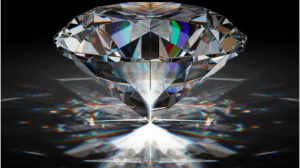
5000+ year Battery Half Life
BY David Szondy,
One problem with dealing with nuclear waste is that it’s often hard to tell what’s waste and what’s a valuable resource. Case in point is the work of physicists and chemists at the University of Bristol, who have found a way to convert thousands of tonnes of seemingly worthless nuclear waste into man-made diamond batteries that can generate a small electric current for longer than the entire history of human civilization.
How to dispose of nuclear waste is one of the great technical challenges of the 21st century. The trouble is, it usually turns out not to be so much a question of disposal as long-term storage. If it was simply a matter of getting rid of radioactive material permanently, there are any number of options, but spent nuclear fuel and other waste consists of valuable radioactive isotopes that are needed in industry and medicine, or can be reprocessed to produce more fuel. Disposal, therefore is more often a matter of keeping waste safe, but being able to get at it later when needed.
One unexpected example of this is the Bristol team’s work on a major source of nuclear waste from Britain’s aging Magnox reactors, which are now being decommissioned after over half a century of service. These first generation reactors used graphite blocks as moderators to slow down neutrons to keep the nuclear fission process running, but decades of exposure have left the UK with 95,000 tonnes (104,720 tons) of graphite blocks that are now classed as nuclear waste because the radiation in the reactors changes some of the inert carbon in the blocks into radioactive carbon-14.
Carbon-14 is a low-yield beta particle emitter that can’t penetrate even a few centimeters of air, but it’s still too dangerous to allow into the environment. Instead of burying it, the Bristol team’s solution is to remove most of the c-14 from the graphite blocks and turn it into electricity-generating diamonds.
The nuclear diamond battery is based on the fact that when a man-made diamond is exposed to radiation, it produces a small electric current. According to the researchers, this makes it possible to build a battery that has no moving parts, gives off no emissions, and is maintenance-free.
The Bristol researchers found that the carbon-14 wasn’t uniformly distributed in the Magnox blocks, but is concentrated in the side closest to the uranium fuel rods. To produce the batteries, the blocks are heated to drive out the carbon-14 from the radioactive end, leaving the blocks much less radioactive than before. c-14 gas is then collected and using low pressures and high temperatures is turned into man-made diamonds.
Once formed, the beta particles emitted by the c-14 interact with the diamond’s crystal lattice, throwing off electrons and generating electricity. The diamonds themselves are radioactive, so they are given a second non-radioactive diamond coating to act as a radiation shield. This means a person sitting next to a diamond battery would receive about as much radiation as they would sitting next to a banana. In addition, the hardness of the diamonds helps keep the radioactive material safe.
“Carbon-14 was chosen as a source material because it emits a short-range radiation, which is quickly absorbed by any solid material,” says Neil Fox from the School of Chemistry. “This would make it dangerous to ingest or touch with your naked skin, but safely held within diamond, no short-range radiation can escape. In fact, diamond is the hardest substance known to man, there is literally nothing we could use that could offer more protection.”
The team has already built a prototype diamond battery that uses the isotope nickel-63 as radioactive fuel and is now moving on to using carbon-14, which will be more efficient. Because c-14 has such a long half life, the researchers estimate a diamond battery would still generate 50 percent of its capacity after 5,730 years
“We envision these batteries to be used in situations where it is not feasible to charge or replace conventional batteries,” says Tom Scott, Professor in Materials. “Obvious applications would be in low-power electrical devices where long life of the energy source is needed, such as pacemakers, satellites, high-altitude drones, or even spacecraft. There are so many possible uses that we’re asking the public to come up with suggestions of how they would utilize this technology by using #diamondbattery.”
The team’s results were presented at the Cabot Institute’s “Ideas to change the world” lecture.
